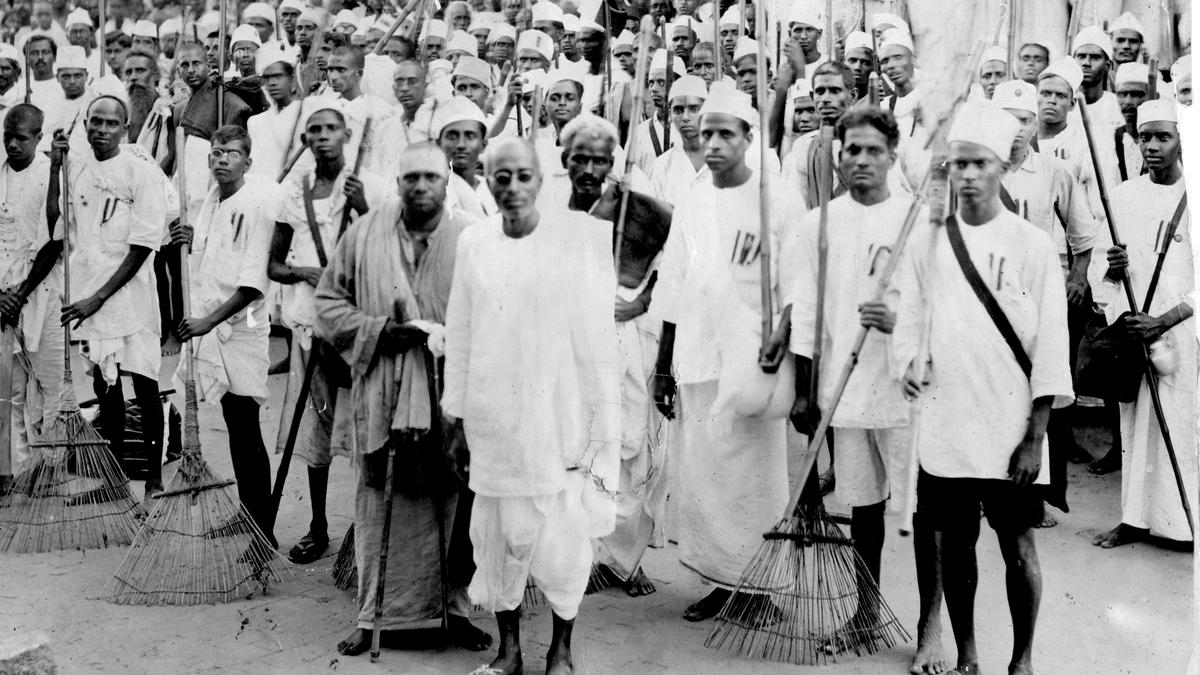
When the historic Civil Disobedience Movement rolled out on the east coast
The Hindu
Mahatma Gandhi's Civil Disobedience Movement expanded to Tamil Nadu with Rajaji leading a salt march in 1930.
In the summer of 1930, Mahatma Gandhi launched the Civil Disobedience Movement to intensify and broaden the freedom struggle. He embarked on a 24-day Salt Satyagraha to oppose the tax imposed on salt. He and his followers marched from the Sabarmati Ashram to Dandi on the west coast.
A week after the Dandi March, his associate and veteran Congress leader C. Rajagopalachari (Rajaji) took up the responsibility of leading the non-violent civil disobedience in the Tamil land. Historian and author Rajmohan Gandhi, the grandson of both Mahatma Gandhi and Rajaji, wrote in his book, Rajaji-A Life, that when the Mahatma decided to break the salt law, Rajaji decided to march with Satyagrahis for about 150 miles (around 240 km) from Trichinopoly (Tiruchirappalli) to Vedaranyam, a coastal town in the erstwhile Tanjore district.
Sardar Vedaratnam Pillai, a salt merchant and Gandhian, who had helped to widen the base of the freedom movement in the erstwhile Tanjore district, was the reason for Rajaji to choose Vedaranyam, rather than Tuticorin (Thoothukudi). When the news about the Satyagraha spread, Tanjore District Magistrate and Collector J.A. Thorne promised the British government an “ignominious failure” of the march, provided he was authorised to arrest all those feeding or housing the marchers for “harbouring criminals” and to arrest Rajaji as soon as he entered the district. The Collector’s plan was to cut off food supplies and shelter to the marchers. His warning that “harbouring” the marchers would invite a six-month jail sentence and a fine was printed in Tamil on leaflets and newspapers and declared by the beat of the drum, writes Mr. Rajmohan Gandhi.
On April 7, 1930, Thorne issued a printed Tamil notice with his signature. On April 10, 1930 and the day after, The Hindu reported the substance and English translation of the notice.
The Hindu also mentioned Rajaji’s comments on the notice. “Mr. Thorne is terrorising the quiet people of Tanjore district with the law relating to harbouring hired rioters. We have no right to expect any better legal knowledge from administrators of this kind. It is unfair to members of the Indian Civil Service, who have no real legal training, to be entrusted with the work of administering the law in India... The Satyagrahis are prepared to lie under the sky or starve in Tanjore soil.”
At 5 a.m. on April 13, 1930, Rajaji came out of the house of freedom fighter T.S.S. Rajan at Cantonment in Tiruchirapalli. Mr. Rajmohan Gandhi writes that there was a complete hush, and tears trickled down some faces when the Satyagraha commenced. After a few seconds, the notes of a song written by poet Namakkal V. Ramalingam Pillai could be heard: “Kathiyindri, rathamindri, yudham ondru varugudhu (Without sword and blood, a war is being waged).” All along, the Satyagrahis received an overwhelming response from people. At one halt, bundles of food were hung on trees.
A. Vedarathinam, grandson of Sardar Vedaratnam Pillai, told The Hindu that after walking 16 days through Tanjore, Kumbakonam, Valangaiman, Semmangudi, Needamangalam, and Thiruthuraipoondi, the Satyagrahis reached Vedaranyam on April 28, 1930. The next day, settled in a camp (now hosting Rajaji Poonga) erected by Sardar Vedaratnam Pillai, the marchers fasted and prayed. At the dawn of April 30, 1930, Rajaji and a few others set out secretly towards a salt swamp near Agasthiyampalli. Sardar Vedaratnam Pillai had deputed three volunteers to smuggle Rajaji through gullies and lanes to avoid police surveillance. They picked up a fistful of salt in defiance of the British Raj.











